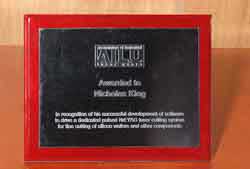2006 - Nicholas King

Nicholas King being presented with the Prize for 2006
by AILU President Malcolm Gowe
The AILU Young UK Laser Engineer’s Prize 2006
went to
Nicholas King
Nicholas King, a young engineer working with Microkerf, the Leicester based laser job shop specialising in precision welding, cutting and drilling has won the 2006 Young Laser Engineers' Prize for his development of software to drive a dedicated pulsed Nd:YAG alignment and laser cutting system.
In detail, the work undertaken by Nick involved the design and development of:
- Hand-shaking between laser and software.
- A dozen jigs designed and manufactured from cast aluminium.
- Vacuum and gas control.
- Laser technology tables for various product thicknesses.
- Algorithms to correct positional and rotational alignment.
- User interface and control softwarecreated in Delphi.
The unit, which has now been in production at Microkerf for 30 hours per week over the past nine months, includes a camera/alignment unit by which printed reference points (fidu¬cials) are picked up from customers free issue product. The coordinates are taken by Nick's software written in Delphi, which then shifts and rotates the geometry so the pattern can be cut out to an accuracy of the order 50 µm.
 Commenting of Nick's work, David Gattwood, Microkerf's MD, pointed out that the program is not specific to any one pattern or application; provided two points are known, the part can be translated and rotated into alignment, no matter what the controller program. "The program automates and simplifies the procedure, rejecting inaccurate measurements and preventing potential damage to jigs. Laser and motion control are all controlled from a single low specification PC," David added.
Commenting of Nick's work, David Gattwood, Microkerf's MD, pointed out that the program is not specific to any one pattern or application; provided two points are known, the part can be translated and rotated into alignment, no matter what the controller program. "The program automates and simplifies the procedure, rejecting inaccurate measurements and preventing potential damage to jigs. Laser and motion control are all controlled from a single low specification PC," David added.
The AILU Young UK Engineer Prize 2006
The Prize is awarded to an individual under 30 years of age in recognition of a significant piece of work, conducted in the UK, which has led to real or potential economic gain for the parent organisation and has wider benefit for the industrial laser user community. In this case, Microkerf avoided the high development cost usually associated with control systems meeting demanding alignment requirements.
"Nick's project demonstrates that a level of alignment can be achieved at low cost using only a personal computer and standard machinery," said David. "The simplicity of the system allows a greater degree of flexibility, permitting its use in a wide range of applications. Examples include: dicing silicon wafers; cutting additional features to already profiled parts; laser trimming pressed panels; cutting of patterned stainless steel; and accurate welding along complex contours."

